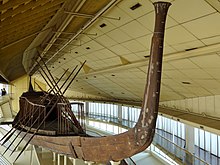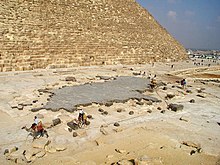User:Hypnôs/sandbox/Pyramid complex of Khufu
The pyramid complex of Khufu (or mortuary complex of Khufu) is the assembly of structures associated with the burial and funerary cult of pharaoh Khufu at Giza. It dates to around 2600 BC, the Fourth Dynasty of Egypt. The centerpiece of the complex was the tomb of Khufu, the Great Pyramid. The funerary cult was practiced in two richly decorated temples which were linked by a causeway. The upper temple lies at the eastern foot of the pyramid. The lower one, called the valley temple, is situated near the floodplain next to a large artificial harbor. A small satellite pyramid and five boat pits for solar barques were also part of the complex.
Several tombs of family members and high officials of Khufu are located in the Eastern Cemetery next to the Great Pyramid. Most notably the three pyramids for his queens, eight double-mastabas for his children and their spouses, and the tomb of Ankhaf who was involved in the construction of the Great Pyramid.
Layout
Plan changes
Pyramid perimeter
Walls
Pavement
Drainage system
Possible stelae
Boat pits

Outside the pyramid's perimeter wall, five boat pits were dug for the burial of Khufu's solar barques: Two on the south side of the pyramid, two on the east side, and one aside the causeway.
Satellite pyramid
Pyramid temple



Causeway

The pyramid temple and valley temple were connected by a monumental causeway. It's foundations were about 9 metres (30 ft) wide, made of local limestone. On it, a roofed corridor was formed by two walls of fine white limestone which were decorated with painted reliefs depicting Khufu smiting his enemies, processions of his estates, and offering scenes.[1][2]
The causeway was approximately 800 metres (2,600 ft) long.[3] It did not run at a right angle to the pyramid temple facade, but slanted about 14 degrees to the north[2] for most of its course, changing direction due north-east about 150 metres (490 ft) before its lower end.[4]
Parts of the causeway were dismantled as early as 2000 BC, and some of stones were reused in the temple and pyramid of Amenemhat I. The section that adjoined the Giza plateau remained visible until the second half of the 19th century, when houses were constructed on its course, sometimes using the causeway's blocks as building material.[5]
The oldest surviving description of the causeway comes from the Greek scholar Herodotus in his work Histories, from the 5th century BC:[6]
For ten years the people were afflicted in making the road whereon the stones were dragged, the making of which road was to my thinking a task but a little lighter than the building of the pyramid, for the road is five furlongs long and ten fathoms broad, and raised at its highest to a height of eight fathoms, and it is all of stone polished and carven with figures.
— Herodotus, Histories
Tunnel
135 metres (443 ft) away from the pyramid temple, a tunnel passes under the causeway. It allowed people passage from the Eastern Cemetery to the north, where a stairway might have led down the plateau. Two pair of holes for wooden beams suggest that the tunnel may have been used for material transport as well.[7]
The tunnel is 3 cubits or 1.57 metres (5.2 ft) wide and 33.85 metres (111.1 ft) long, leaving a ceiling of bedrock 1.20 metres (3.9 ft) thick for a span of 10.15 metres (33.3 ft).[7]
Valley temple
At the lower end of the causeway stood a second temple of Khufu, the so-called valley temple.
Harbor
Reliefs
The two temples and the causeway connecting them were decorated with painted reliefs.
Valley temple
| Image | Scene depicted | Fragment size |
|---|---|---|

|
Titulary of Khufu | 61 x 25 cm |
| Two scenes: Personified estates bringing offerings; royal palace | 123 x 43 cm | |

|
Female personification of the estate "Khufu is beautiful" | 22 x 27 cm |
| Procession of oxen with inscriptions: "the tribute from Tefrer belonging to Khufu", "The surrounding territories serve Khufu", "The surrounding lands act for Khufu" | 129 x 43 cm | |

|
Inscription: "... in the [Horizon-of]-Khufu ... building the sanctuaties of the god(s) ..." | 37 x 32 cm |

|
Papyrus boat and inscription of the name of the vessle: "(bird-)catching boat of Khufu" | 89 x 36 cm |
| Ships under sail | 35.5 x 32 cm | |
| Ship under sail | ||
| Sailing scene | 58 x 27 cm | |

|
Two soldiers running with a coil of rope |
Causeway
| Image | Scene depicted | Fragment size |
|---|---|---|
| Vulture carrying ankh | 16 x 11 cm | |
| Hawk | ||

|
Khufu, wearing the red crown, performing ceremonies connected to the Heb-Sed feast during ritual visit to Heliopolis | 110 x 112 cm |
| Two scenes of the Heb-Sed feast (possible Saite restoration) | 175 x 27 cm | |
| Khufu performing ritual dance | 35 x 30 cm | |
| Inscription that may depict part of the name of the Great Pyramid, Akhet Khufu | 27 x 25 cm | |
| Hoopoe | 90.5 x 56 cm |
Pyramid temple
| Image | Scene depicted | Fragment size |
|---|---|---|

|
Wepwawet | 43 x 42 cm |
| King in a short coat | 37 x 36 cm | |
| King, probably at coronation | 35 x 35.5 cm | |
| Standing king | ||
| King with a member of his suite | 32 x 54 cm | |
| Officials in the king's suite | 28 x 17 cm | |
| Sed festival scenes with the goddess Meret | 77 x 64.5 cm | |
| Officials at the Sed festival | 68.5 x 69 cm | |
| Semet priest at the Sed festival | ||
| Three figures | 103 x 51 cm | |
| Two male figures | ||
| Male figure | ||
| Attendant with a sunshade | 40 x 38 cm | |
| Procession of members of the royal suite | 42 x 44 cm | |
| Stern of a boat being paddled | 22.5 x 19 cm | |
| Controller of the palace with sash and emblem of goddess Bat | ||
| Booths for the Sed festival above black band with stars | ||
| Woodcutter among trees | 90 x 28 cm |
Other reliefs
Some of the relief fragments from Khufu's pyramid complex could not be attributed to a particular structure.
| Image | Scene depicted | Fragment size |
|---|---|---|

|
Archers | |

|
Billy goats | |
| Inscription and traces of a ship | 58 x 35 cm |
Other tombs
Queens' pyramids
Funerary cache of Khufu's mother
Mastabas of Khufu's children and their spouses
Double mastabas
Workers' town
Palace
References
- ^ Hawass 2005, p. 318-319.
- ^ a b Maragioglio & Rinaldi 1965, p. 68.
- ^ Lehner 2021, p. 920.
- ^ Jones 2021, p. 772.
- ^ Hassan 1960, p. 18.
- ^ Herodotus. Histories. Vol. 2. Translated by Godley, Alfred Denis. pp. 425–431.
- ^ a b Hawass 2005, p. 320.
- ^ Goedicke 1971, p. 11-23, 100-106.
- ^ Hassan 1960, p. 20-24, 34-38.
- ^ Porter & Moss 1974, p. 11.
- ^ Hawass, Lehner & Jones 2020, p. 1, 17.
- ^ Goedicke 1971, p. 29-47, 56-59, 95-96.
- ^ Metropolitan Museum of Art 1999.
Sources
- Goedicke, Hans (1971). Re-Used Blocks from the Pyramid of Amenemhet I at Lisht.
- Jones, Michael (2021). "The Remains of the Causeway and Valley Temple of the Pyramid of Khufu: Rescue Archaeology and Preservation through Documentation". Guardian of Ancient Egypt. Vol. 2. pp. 771–792. ISBN 978-8073089788.
- Lehner, Mark (2021). "Merer and the Sphinx". Guardian of Ancient Egypt. Vol. 2. pp. 895–925. ISBN 978-8073089788.
- Goyon, Georges (1969). "La chaussée monumentale et le temple de la vallée de la pyramide de Khéops" [The monumental causeway and the valley temple of the pyramid of Khufu]. Bulletin de l'Institut français d'archéologie orientale (BIFAO) (in French) (67): 49–69.
- "Great Pyramid Temple Conservation Project". American research center in Egypt.
- Hassan, Selim (1960). The Great Pyramid of Khufu and its Mortuary Chapel. Excavations at Giza. Vol. 10.
- Hawass, Zahi (2005). "Khufu's National Project: The Great Pyramid of Giza in the Year 2528 B.C." (PDF). In Jánosi, Peter (ed.). Structure and Significance: Thoughts on Ancient Egyptian Architecture. pp. 305–334.
- Hawass, Zahi; Lehner, Mark; Jones, Daniel (2020). "The Great Pyramid Temple Project" (PDF). AERAgram. 21 (1 & 2): 1, 10–17. ISSN 1944-0014.
- Maragioglio, Vito; Rinaldi, Celeste (1965). L'Architettura delle Piramidi Menfite 4. Le Grande Piramide di Cheope [The architecture of the pyramids of Memphis: The Great Pyramid of Cheops] (in English and Italian).
- Metropolitan Museum of Art (1999). Egyptian Art in the Age of the Pyramids.
- Porter, Bertha; Moss, Rosalind (1974). Málek, Jaromir (ed.). Topographical Bibliography of Ancient Egyptian Hieroglyphic Texts, Reliefs, and Paintings (Giza pages only). Vol. 3. The Clarendon Press.
